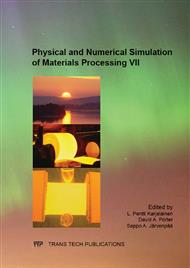p.116
p.122
p.128
p.134
p.140
p.146
p.152
p.158
p.165
Softening Kinetics in High Al-Nb Microalloyed Steels
Abstract:
The combined effect of Al and Nb additions on the static softening behavior of C-Mn steels was investigated. The compositions of the steels studied in this work are representative of the recently developed TRIP-assisted steels: a base composition of 0.2wt.%C, 2wt.%Mn, 50ppmN, three different Al levels, 0.03 (base steel), 1 and 2wt.%, and two Nb contents of 0.03 and 0.07wt.%. Double-hit torsion tests were performed at different deformation temperatures (925-1065oC) and pass-strains (=0.2 and 0.35). It was found that solute Al produced a significant retardation on the static softening kinetics, this effect being enhanced by the addition of Nb. Additionally, below 1000oC the addition of 2 wt.%Al promotes the γα phase transformation to occur concurrently with softening. For the Nb microalloyed steels strain induced precipitation also occurred, resulting in a complex interaction between softening, phase transformation and strain induced precipitation.
Info:
Periodical:
Pages:
140-145
Citation:
Online since:
July 2013
Authors:
Price:
Сopyright:
© 2013 Trans Tech Publications Ltd. All Rights Reserved
Share:
Citation:


